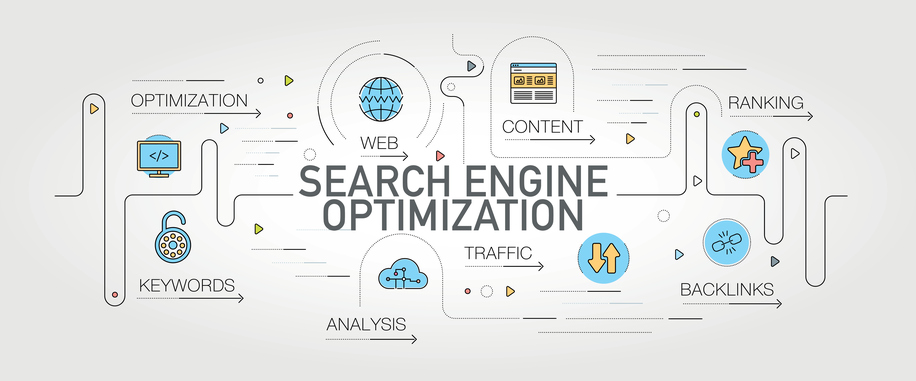

Search Engine Optimization
You know that sinking feeling when you dash into your local supermarket to pick something up in a hurry, and they’ve changed everything around? All you can think is: great, all I need is a carton of milk and a tin of cat food, but now I’ll have to waste twenty minutes wandering about trying to figure out where the hell they’re keeping it today.
Now imagine that this supermarket doesn’t just have some annoying redesign every six months or so – they do it every single day. Every morning, when customers arrive, they’re faced with thousands of products spread over dozens of aisles, and no idea where to find what they want without help.
Every day, billions of new pieces of information are thrown onto this mammoth pile, and search engines like Google have to figure out how to organise them so that users can navigate to what they need.
If you were one of the brands whose products are stocked in that supermarket, you’d want to make sure that the overworked shop assistants could tell immediately what each item is and where they should put it. You’d want to make your products jump out and look familiar so that customers can locate it in a hurry. And you’d want to do plenty of research on how the supermarket organizes and directs people around the store, so that you can label products in a way that fits with their system – and your stuff doesn’t end up left in the store room gathering dust.

SEO stands for Search Engine Optimization, and that’s exactly what it does – it optimises your content for search engines.
When someone searches for a particular term, Google (or Bing, or whatever search engine you’re using) scans through millions of websites looking for matches and suggests the ones THEY think are most relevant. If the person searching for that term clicks their suggestion and stays on the site, they take this as a sign they’ve got it right.
If a lot of people clicking the link take one look at it and leave immediately Google takes this as a sign that the page wasn’t much help – and pushes it down the list of suggestions for next time.
Firstly, you need to clearly label your content using the same language as your intended audience – the terms they enter into the search engine – so that Google knows where to put your stuff and who to show it to.
Secondly, you need to make sure that when people click through to your site, they get useful, relevant, high quality content that’s easy to find their way around.
There are a whole bunch of tools you can use to figure out what keywords and search terms to focus on.
These tell you how many times a particular term is searched each month, giving you a better idea of how your potential customers frame their queries – and how to word your site.
For example, imagine you’re a geospatial company that specialises in remote sensing technology.

This means that, in theory, you could show up in nearly twenty times as many searches, simply by changing this sentence:
“We specialise in remote sensors for mapping the surface of the Earth”
To this:
“We specialise in remote sensing technology for mapping the surface of the Earth”
Search engines understand that different elements on the page carry different weight. Google will pay more attention to a keyword that shows up in a title or header than to keywords that turn up in the body text.
That’s because putting a keyword in a header makes it clear that this is the main focus of the page or section – it’s not just a passing reference.
So, to use the example above, if you have a header on a page (marked out in HTML with proper <H1> or <H2> tags so that the search engine KNOWS it’s a header!) that says: “Remote Sensing Technology for Geospatial Analysis”, Google feels pretty damn confident that someone searching for “remote sensing” and “geospatial analysis” will find your site useful.
To a lesser extent, putting a keyword in bold, italics or a bulleted list also sends the message to your search engine that this is more important than the others, i.e. that this is an important term that shows what your site is about.
Using a keyword a couple of times on the page helps to make it clear that this the point of the site, too. Just don’t go nuts, as we’ll look at in a moment.
Oh, and make sure you include keywords in the file names of any images you use – and in the ALT text for that image, too – especially if you’re using the image to link to another page. Search engines gather clues about what the destination page site is about from what the links to it say. This also means that text links are generally better than images, as they provide more information!
Put simply, If you stuff your site with keywords but don’t deliver answers, solutions or helpful information, the visitor will “bounce” straight off it.
Then, Google’s robots will think, uh-oh, this site isn’t great, so let’s push it further back in the queue of search results.
This means that simply squishing in as many keywords as possible can actually do you much more harm than good.
Case in point: if you’re more worried about replicating a search term than writing like a human, your audience will spot that, and they’ll be suspicious of your site. Plus, by chasing the most popular terms instead of the most accurate ones for your site, you could be attracting the wrong audience.
For example, let’s say you sell drones to the geospatial industry for site scanning and surveying.
The terms “video drone” and “camera drone” are a LOT more popular than the terms “drone surveying” and “site scan.” But if you try and shoehorn in references to “video drone” or “camera drone” where it doesn’t really flow, your readers will be put off.
And, of course, you’ll also get tens of thousands of hits from ordinary people searching for videos taken by amateur drone filmmakers, or who are looking to buy a drone off Amazon for a couple of hundred quid. You might get more traffic, but it’s useless to you.
Better to get 100 potential customers finding you by searching for “drone surveying” than half a million who turn out to be teenagers searching for cool drone footage!
Having outsiders link to you is one of the best things you can do for your SEO. Basically, the more times Google or Bing see a link back to you, the more likely they are to think you’re a trustworthy site and push you up their rankings.
This can only happen when you produce top quality content. That’s why blogging, as well as other forms of content marketing, are so valuable – they give people a reason to post links to your site, boosting your credibility and making you more likely to show up in searches in the long run.
Here’s how Peter Kent, author of SEO for Dummies, sums up what you need to do for effective SEO:
“Here’s the ideal optimized page:
Lastly, remember that this stuff takes time and effort. Great SEO is essential, but it takes effort. You need to win people’s trust, give them plenty of first rate content, and take the time to test out what works.
There are no cheats to it – but when you get it right, it’s worth the work. I promise.
Ready to take your geospatial marketing to the next level? Give me a call today on +447825 517 850 Skype: elaine_ebtm or email elaine @ elaineball.co.uk for a chat about how we can help!
How often do you use Google on an average day?
If you’re anything like me, you probably use Google Search at least a dozen times a day – it’s my default for checking or researching everything from train times to marketing strategy to how to spell an unusual name. And that’s before I’ve even factored in Google Maps (I can barely find my way out of the house without it) or tools like Gmail and Google Drive that help me stay in touch with colleagues and clients and run my projects more efficiently.
And then there are all the other cool products and services Google is famous for. The amazing stuff going on inside the top secret Google X Lab. Google Analytics and Adwords that revolutionised online marketing. Heck, I’m even using the Google Chrome browser right now.
Basically, Google has created the most formidable brand in the world. They’re known as being ahead of the curve. Of embracing new tech and ideas before their competitors even cottoned on to how big these things were going to be. Their laid-back, creative-nurturing corporate culture is so famous that 7 year olds are writing to the CEO (and getting replies!) to say that their dream is to work there when they grow up.
Google isn’t just a tech company, or a search engine, or a service provider, or whatever. What makes it a success is the fact that they know exactly who they are and what they stand for, and this runs through everything they do.
Yes, their actual products change and evolve – but the core message does not. They’re excited about what they do and what they can do in the future, and that’s what’s so compelling to their clients and users.
Now compare that to one of their biggest competitors, back in the early days: Yahoo.
When Yahoo started, it was a cool idea. In the early days of the internet, when it was hard to locate the good sites out there, two Harvard buddies had this stroke of inspiration and invented a system for keeping track of their favourites. As searching became easier, they developed their idea into a search function. So far, so good… but then what?
In 24 years, do you know how many times Yahoo has changed its mission statement?
… 24 times.
That’s once a year.
Yes, once A YEAR, Yahoo completely scraps whatever it is it’s supposed to stand for and comes up with a new brand identity.
But that’s not a brand. That’s a case of frantically scrambling after whatever’s hot right now. Read: whatever Google’s up to. Whatever someone who DOES know what they’re aiming for manages to have some success with.
And you know what?
Yahoo is crumbling.
It has been failing for years… because it doesn’t know what the hell it is, what it stands for or where it’s going.
The tech branding expert Denise Lee Yohn, who used to head up branding and strategy for Sony Electronics, summed up the problem perfectly when she wrote:
“Yahoo has also been vision-less. While many credit [Melissa] Mayer with leading the company’s transition to mobile, the shift was born out of necessity to catch up with the world, not out of opportunity to change it. In fact, Yahoo has been operating in reactive mode for the last decade. Even the new homepage design it recently introduced is merely an incremental evolution of its past designs and its latest attempt to mimic the popular features of other sites.”
In fact, even when Yahoo tries its level best to drag itself back into the running, it comes off as just listing things Google does well and planning to rip them off as a ‘strategy’:
“Yahoo doesn’t have a brand vision that would propel it forward, leapfrogging over existing realities and pushing the limits of what is possible. Mayer once described her vision for the company’s future saying, “As digital content becomes richer, as search and mail become richer, we need to change what the format of that guide is, as we move to mobile, wearables, TVs, cars, and all the other formats in the future. So, we’re focused on search, communications and digital content, all of which we think are incredibly important parts of that role as a guide, and those are the products that we’re investing in and building on.” Her statement merely reflects the company’s reactive stance to changes that it must address — not new growth opportunities it is creating for itself.”
In its heyday, Yahoo was valued at over $100 billion.
Guess how much Verizon bought it for last year.
No, really – guess. It will shock you.
… $4.83 billion.
That’s a collapse of 96% of its value. Can you imagine what would happen if your company lost 96% of its value?? But that’s what happens when you have a decent piece of tech, but no brand to back it up.
Now I want you to think for a moment about the geospatial sector.
How many players in your market do you know that genuinely have a “brand”?
I don’t mean a good offering. I don’t mean a product or a service that does what their clients need them to do. I mean a BRAND.
Put another way, how many companies in your corner of the geospatial industry can you look at and say: yeah, I get what those guys stand for. I get what they’re about. Not just what they do or make, but what their vision is. What they represent. Where they’ll be in 5 or 10 years’ time.
And what about your company? Can you say that about yourselves? Could your clients answer those kinds of questions about YOU?
Because here’s the thing. Right now, you might think that stuff doesn’t matter. Perhaps you’re the only guys on the block doing what you do. You’re one of the few companies that makes the particular piece of equipment or software that your clients are desperate for.
Well, that’s what Yahoo thought, too.

Drone dude coming to steal your customers!
But sooner or later, the Google of your industry is going to come along. They’re going to target the same customers and try to fix the same problems. But they’re also going to have this exciting, passionate brand story to go with it. They’re going to push the idea that they alone are the big-vision innovators. That they are the future of your sector.
And you know what? Your clients are going to buy into it. Because branding is just that powerful. Yes, even in our low-key, geeky, tech-heavy, super-practical, no-nonsense industry, your brand – what people think your company represents – matters.
Don’t wait around
So don’t wait around for some shiny new competitor to come marching in with their awesome brand and turn your company into a future Yahoo. Don’t risk throwing away nine-tenths of what you’ve worked for because you didn’t think early enough about who you are as a company, where you’re going and what image your clients have of your role in the sector.
You’re in the amazing position right now of being in an industry that has been slow to realise the full power of a compelling brand. So instead of letting someone else steam ahead and leaving you picking up the dregs of their business or copying all the stuff they do well, it’s time for you to be proactive.
Lead the way in creating that incredible brand and I promise you, you’ll find it one hell of a lot easier to push your way to the front of the queue.
Feeling inspired? Give me a call on +44 (0) 7825 517 850 | Skype: elaine_ebtm | email: elaine @ elaineball.co.uk to talk through how we can turn your brand into the Google of the Geospatial Industry!